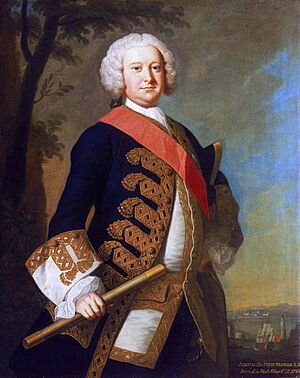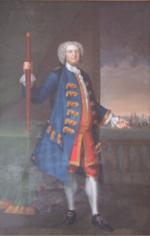Peter Warren (Royal Navy officer) facts for kids
Quick facts for kids
Sir Peter Warren
|
|
|---|---|
 |
|
| Member of Parliament for Westminster |
|
| In office 1747–1752 |
|
| Preceded by | Charles Edwin Viscount Perceval |
| Succeeded by | Edward Cornwallis Viscount Trentham |
| Personal details | |
| Born | c. 1703 Warrenstown, Ireland |
| Died | 29 July 1751 (aged 47–48) Dublin, Ireland |
| Spouses | Susannah Delancey (m. 1731) |
| Children | 6, including Anne |
| Military service | |
| Allegiance | Great Britain |
| Branch/service | Royal Navy |
| Years of service | 1716–1752 |
| Rank | Vice-Admiral of the Red |
| Commands | HMS Falkland HMS Grafton HMS Solebay HMS Leopard HMS Squirrel HMS Devonshire |
| Battles/wars | |
| Awards | Knight Companion of the Order of the Bath |
Sir Peter Warren (born around 1703 – died 1752) was an important naval officer and politician from Ireland and Britain. He was a Vice-Admiral in the Royal Navy and also served in the British Parliament for Westminster from 1747 to 1752.
Warren is most famous for his long career in the Royal Navy, which lasted 36 years. He took part in many naval battles. His most notable achievement was helping to capture the French fortress of Louisbourg in 1745.
He was born in Ireland to an Irish Catholic family. His parents raised him as a Protestant so he could join the navy. In 1716, he joined the Royal Navy. He spent many years fighting pirates and Spanish ships in West Africa and the Caribbean. By 1727, he became a post-captain.
From 1728 to 1745, Warren mostly served in the Americas. He married Susannah Delancey in New York in 1731, and they had six children. He was involved in battles during the War of Jenkins' Ear, including attacks on St. Augustine and Cartagena. In 1745, he led a blockade that helped capture Louisbourg.
After a major victory at the First Battle of Cape Finisterre in 1747, he was made a Knight. He then returned to England and became a Member of Parliament. Sir Peter Warren died in Dublin in 1752. Two towns in the USA, Warren, Rhode Island and Warren, New Hampshire, are named after him.
Contents
Peter Warren was born around 1703 in Warrenstown, Ireland. He was the youngest son of Michael Warren, an army officer, and Catherine Aylmer. Even though his parents were Catholic, they raised Peter as a Protestant. This was important because Catholics in Ireland were not allowed to join the Royal Navy at that time.
In 1716, Peter followed his brother Oliver and joined the Royal Navy. He started as an ordinary seaman on the ship Rye. His uncle, Matthew Aylmer, helped him get started.
For about ten years, Warren served off the coast of West Africa and in the Caribbean Sea. During this time, he helped fight pirates and dealt with Spanish coast guard ships.
Rising Through the Ranks
On July 23, 1724, Warren was promoted to lieutenant while serving on the Guernsey. Three years later, he took command of the Falkland.
In 1727, he quickly rose through the ranks. He became a commander on May 28 and then a post-captain on June 19. In 1728, he was given command of the Grafton and served with the Baltic Fleet.
Serving in the Americas
Warren did not stay long in the Baltic Sea. He soon joined the Mediterranean Fleet. There, he took command of the Solebay. He used this ship to deliver news of the Treaty of El Pardo to Jamaica and Veracruz in 1728.
From 1730 to 1732, he commanded the Solebay in North America. He operated off the coasts of New York and South Carolina. In 1734, Warren joined the Western Squadron and commanded the Leopard until 1735.
By 1736, Warren was back in New York. He became captain of the Squirrel and held this command until 1741.
Battles and New Squadrons
When the War of Jenkins' Ear began, Warren took part in a failed attempt to capture St. Augustine in 1740. After this battle, he sailed to Jamaica. He served under Edward Vernon in another failed British attack against Cartagena in 1741. By January 1742, he was back in New York, commanding the Superb.
In 1742, Warren suggested to the British Admiralty that a new group of ships should be formed. These ships would serve in the West Indies during the winter. The Admiralty liked his idea and made him the commander of this new squadron. This squadron became famous for capturing many French ships during the War of the Austrian Succession.
Capturing Louisbourg
In 1745, Warren was part of a big mission against the French fortress of Louisbourg. Warren led his ships to Canso in April 1745. There, he joined forces with a British army. They then sailed towards Louisbourg and set up a blockade around its harbor.
His fleet captured a French ship called the Vigilant on May 20. Soon, more British ships arrived. With these reinforcements and a planned attack, the fortress surrendered on June 28.
Warren was highly praised in Britain for his role in capturing Louisbourg. He was promoted to rear-admiral on August 10, 1745. He was also made the first governor of Cape Breton Island. However, Warren asked the Admiralty for a replacement because he wanted to become the governor of New York. He was relieved of his governor duties in June 1746.
Later Life and Political Career
After returning to England, Warren suggested a new plan for invading New France. However, the Admiralty decided they couldn't do it because they needed ships for other blockades. Instead, Warren was ordered to lead a squadron of eight ships to help protect Louisbourg. Later, he was told to join a fleet under George Anson in the Bay of Biscay. This fleet was looking for French warships.
Battle and Knighthood
In May 1747, Warren was part of the British fleet that fought a French force. This battle happened off Cape Finisterre, and the British won. As a reward for his bravery, Warren was made a Knight of the Bath. He also received a large sum of money, £31,496, from captured enemy ships.
In June of that year, he was promoted to vice-admiral. He was given command of the Western Squadron. However, he handed control of the squadron to Edward Hawke in August due to illness. In 1748, the Treaty of Aix-la-Chapelle was signed, which ended the ongoing war.
Entering Politics
Warren then focused on politics. He was elected to the House of Commons in the 1747 British general election. He represented the area of Westminster.
In Parliament, Warren disagreed with a part of the 1749 Consolidation Act. This part said that naval officers who were not actively serving (on half-pay) could still be put on trial by a court-martial. Warren convinced the Admiralty to remove this part. This decision, however, caused a lasting disagreement between him and George Anson.
Warren was also very active in parliamentary committees. He led several of them and even presented new laws to the House of Lords himself. He strongly believed in having a powerful Royal Navy and forming alliances with other European countries to stand against France. He also discussed British currency, overseas trade, fishing, and border issues in Britain's colonial empire. In 1747, Warren even suggested new uniforms for the Royal Navy, especially for high-ranking officers like admirals and captains.
As his political career grew, Warren settled in London and bought a home at 15 Cavendish Square. In 1752, he was chosen to be an alderman for the ward of Billingsgate. He didn't want this job and paid a small fine to be excused. While visiting Dublin, Warren died of a fever on July 29, 1752. He was buried in Warrenstown. After his death, a famous sculptor named Louis-François Roubiliac created a monument to Warren in Westminster Abbey.
Personal Life and Legacy
During his time in the military, Warren earned a lot of money, over £127,405, mostly from capturing French and Spanish ships during the War of the Austrian Succession. He used his wealth to buy large amounts of land in Britain and the Thirteen Colonies. He also ran a moneylending business in England, Ireland, and North America.
Warren owned land in Hampshire, England, New York, and Pennsylvania. In 1732, he asked his nephew William Johnson to manage his estates in the Mohawk Valley region. Johnson's job was to clear the land, settle European workers, and build trade relationships with local Native American tribes. On his American estates, Warren owned a number of slaves. In 1744, he bought over twenty enslaved people to work for Johnson.
In July 1731, Warren married Susannah Delancey. They had six children together. Sadly, his only son and one daughter died in a smallpox outbreak in 1744. When he was offered a special title (a baronetcy) the next year, he turned it down because he no longer had a son to pass it on to. Warren's oldest daughter, Anne, married Charles FitzRoy in 1758. His third daughter, Charlotte, married Lord Abingdon in 1768.
Many places in England and North America were named after Warren during and after his life. The towns of Warren, Rhode Island and Warren, New Hampshire are named after him. Several streets in Charleston, South Carolina, London, Louisbourg, and New York City also bear his name. Warren's role in capturing Louisbourg helped spark a lot of interest in North American affairs among the British public for the first time.
Images for kids




